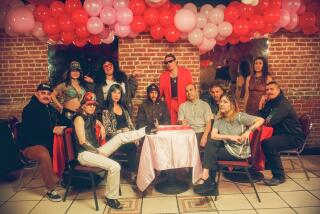Dancers Take ‘Solo Flight’ in LACE Program
- Share via
Racism and sexual ambiguity have always been part of choreographer Donald Byrd’s life, but not his art. Indeed, he says he’s kept these controversial issues away from his work with his company for fear of clouding “straightforward movement issues with the cult of personality.”
But that desire for discretion changed when, after nearly 15 years of choreographing dances for others, he created a dance for himself.
“The results were traumatic,” he admits, referring to his “Face Changers,” where he sashays around the stage in drag before performing percussive steps that mix ballet with African dance.
“I used to hide behind the skill of my dancers,” he confesses. “But all of a sudden, when I was alone, I had no choice but to hold a mirror up to my entire being and place that on stage.
“The process changed the way I make work for my company,” Byrd admits, “Now it’s become more visceral and intimate.”
He’s not alone in finding that solo work rejuvenates and expands a choreographer’s ability to create, albeit through painful reevaluation.
Byrd, Mary Jane Eisenberg, Susan Rethorst and Yves Musard are featured in a modern-dance program titled “Solo Flight” at LACE from tonight through Saturday. These artists, nationally respected for leading moderate-sized, experimental companies, will step back from directorial roles to lend insights into the relationship between their inner lives and the subtle way a dance gets made.
For Eisenberg, the process has bordered on what she calls “a kind of small death.” She says that her latest piece, called “A Woman Must Keep Moving,” centers on abrupt changes in her inner life that are so dramatic she likens them “to ritual decay and rebirth.”
Using spoken text, props, Balinese music and what she calls “gestural, non-balletic movement,” Eisenberg says this performance artwork is a kind of “transformative ritual” that helps her deal with “psychic, physical, sexual and career changes” erupting in her life now.
Susan Rethorst uses solo work in a similarly ritualistic way. Though she’s known for making group dances--she was awarded a Bessie Award for one in 1985--she confesses that she works alone when “it’s time to re-evaluate and transform the deep and mysterious mind/body connections” that have driven her since the ‘70s.
Rethorst’s dances often feature only women, and have been likened stylistically to Virginia Woolf’s prose for their seemingly internal and poetic manner of constructing emotional and private languages.
But even Rethorst experiences the dance equivalent of writer’s block.
“A few years back, I had a series of physical problems that I was working on,” she explains. “I would place a limb somewhere and just look at it and think ‘Well, it makes a plane or a line or an angle. And I would ask myself in the most basic and deep way how these placements can be combined to make a dance that makes sense to me?
“It was a dialogue I worked out by myself in ‘Twain,’ ” she says, referring to one of the dances she’ll present at LACE. “The solo was a kind of research.”
Yves Musard, a French-born choreographer, sees “no distinction between research and dancing.” In fact, he hopes that when audiences watch his figure contorting on stage, they are aware that he is “not so much performing for them,” but “working something out for myself.”
“Audiences always think I am so serious and dark,” he offers with a laugh, referring to his reputation for twisting his expressive face into Kafka-esque frowns while tumbling, jumping and slogging on the dance floor as if he were a peasant farmer.
“But I am really just concentrating on my steps,” he adds. “My dances offer me one thing: knowledge.”
Musard explains that there is no “separation between who I am, what I know and how I dance.” And though he says that his solo work “Spain” may remind viewers of flamenco dancing and other Spanish references, it is not different from all his other pieces.
“I feel a little like a spider,” he explains. “I go along and spin a web and the web is knowledge. My movements are about making my body able to perceive and feel and spell and write and learn what I don’t always have the knowledge of but I know exists in me.
“I can’t imagine making group works without having gone through this private work,” he comments.
“Now, when I work with other dancers,” he adds, “it’s no different. I ask them to concentrate and express something beyond themselves. I believe each is a soloist with his own way of moving, his own way to gain knowledge.
“It looks very heavy sometimes to the audience, but it can be absorbing and powerful because the performer is at the edge of something--whatever it is--and that’s a deep thing.”
More to Read
The biggest entertainment stories
Get our big stories about Hollywood, film, television, music, arts, culture and more right in your inbox as soon as they publish.
You may occasionally receive promotional content from the Los Angeles Times.










